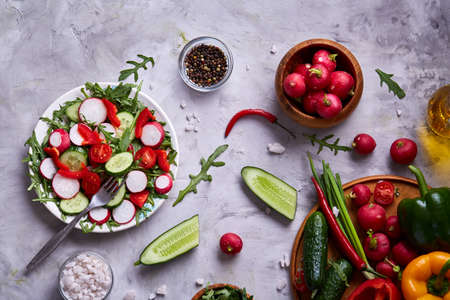Understanding Redness: Common Causes and How Diet Plays a Role
When it comes to skin redness, many Americans experience irritation, blotchiness, or flushing that can be both uncomfortable and impact confidence. Redness often shows up as a sign of sensitive skin conditions like rosacea, eczema, or just general inflammation. While genetics, environmental triggers (think: sun exposure or harsh weather), and lifestyle factors like stress play a part, what you eat also matters more than you might think. In the US, common dietary habits—such as consuming spicy foods, processed snacks, or high-sugar drinks—can sometimes worsen redness in susceptible individuals. On the flip side, nourishing your body with anti-inflammatory foods supports your skin from within and may help reduce those unwanted flare-ups. Understanding these connections is key to making empowered food choices that support your skin’s health every day.
2. Foods to Fight Redness: What to Load Up On
When it comes to calming skin redness from the inside out, what you eat really matters. The good news? Many anti-inflammatory, skin-soothing foods are easy to find in grocery stores and farmer’s markets across the U.S. Loading up on these nutrient-rich options can help reduce irritation and support a healthy complexion.
Leafy Greens: Nature’s Anti-Redness Allies
Spinach, kale, collard greens, and Swiss chard are packed with vitamins A, C, E, and K—antioxidants known for their ability to fight inflammation and protect skin cells from damage. These greens are also high in fiber and phytonutrients that support overall wellness. Try tossing them into salads, smoothies, or sautés for a delicious boost.
Fatty Fish: Omega-3 Powerhouses
Wild-caught salmon, mackerel, sardines, and trout are rich in omega-3 fatty acids. These healthy fats have been shown to decrease inflammation in the body, which can help reduce facial redness caused by conditions like rosacea or eczema. For best results, aim for two servings of fatty fish per week.
Berries: Antioxidant Superstars
Blueberries, strawberries, blackberries, and raspberries are bursting with antioxidants such as vitamin C and polyphenols that defend your skin against oxidative stress—a common trigger for redness flare-ups. Berries are easy to enjoy year-round in America and make a sweet addition to yogurt bowls or oatmeal.
Quick Reference: Best Anti-Redness Foods
| Food Group | Examples | Main Benefit |
|---|---|---|
| Leafy Greens | Kale, Spinach, Chard | Antioxidants & Vitamins |
| Fatty Fish | Salmon, Sardines, Trout | Omega-3 Fatty Acids |
| Berries | Blueberries, Strawberries | Polyphenols & Vitamin C |
Pro-Tip:
If you’re new to these foods, start simple—add a handful of spinach to your morning smoothie or swap out a dinner protein for grilled salmon once a week. Your skin will thank you!

3. Foods That May Trigger Redness: What to Cut Back On
If you’re on a mission to calm skin redness from the inside out, it’s just as important to know what foods might be making things worse. In the American diet, some everyday favorites can actually trigger or worsen facial flushing and sensitivity, especially for those prone to conditions like rosacea. Let’s break down the biggest culprits:
Spicy Foods
Hot wings, salsa, and that extra jalapeño kick might taste amazing, but they can also dial up skin redness. Spices like chili peppers contain capsaicin, which increases blood flow and can spark a flush in sensitive skin types. If you notice your face heats up after Taco Tuesday, it may be time to go mild.
Dairy Products
While a creamy latte or cheesy pizza is a staple for many, dairy products are linked to increased inflammation and redness in some people. Milk, cheese, and ice cream could aggravate your skin if you’re sensitive—try swapping for plant-based alternatives to see if your complexion calms down.
Alcohol
From happy hour cocktails to weekend wine nights, alcohol is woven into social life across America. Unfortunately, it’s also a well-known redness trigger. Alcohol dilates blood vessels and dehydrates your body (and skin), leading to visible flushing. Consider moderating your intake or opting for non-alcoholic options when possible.
Highly Processed Snacks
Chips, cookies, fast food fries—these processed treats are everywhere and oh-so-convenient. But their high salt, sugar, and unhealthy fat content can stoke systemic inflammation that shows up as red or irritated skin. Try reaching for whole-food snacks like nuts or fresh fruit instead.
The Takeaway
You don’t have to give up every comfort food cold turkey, but being mindful of these common triggers—and how your skin responds—can help you put your best face forward. Small swaps add up over time!
4. Smart Swaps: Easy Substitutions for a Calm-Complexion Diet
Making lasting changes to your diet doesn’t have to be overwhelming or mean giving up your favorite foods. By focusing on smart, culturally relevant swaps, you can support your skin while still enjoying the flavors and dishes you love. Whether you’re eating at home or out with friends, these easy substitutions will help reduce redness triggers and boost skin-calming nutrients.
Simple Everyday Swaps
| Instead of… | Try This! | Why It Works |
|---|---|---|
| Spicy Sriracha sauce | Mild hummus with herbs | Reduces heat-triggered redness; adds skin-loving antioxidants |
| Cow’s milk in coffee | Oat or almond milk | Dairy can be a trigger for some; plant-based options are gentler on skin |
| White bread toast | Whole grain or sprouted bread | More fiber and B vitamins, which help calm inflammation |
| Pasta with heavy tomato sauce | Brown rice pasta with olive oil & roasted veggies | Less acidic and packed with anti-inflammatory fats and phytonutrients |
Culturally-Inclusive Choices
- Taco Night: Swap spicy salsa for avocado slices or mild pico de gallo. Choose corn tortillas over flour for extra fiber and less gluten.
- Asian Cuisine: Pick steamed dumplings over fried ones, and ask for sauces on the side to control spice and sodium levels.
- BBQ & Grilling: Marinate proteins in yogurt, lemon juice, and turmeric instead of hot sauces—turmeric is naturally anti-inflammatory!
Sustainable Change Tips
- Start small—switch one ingredient at a time so your taste buds can adjust.
- Get creative—explore new herbs, spices, and ingredients that add flavor without triggering redness.
- Share your journey—invite friends or family to try new recipes together, turning healthy swaps into fun social experiences.
Your Plate, Your Power
The key is flexibility: don’t stress if you indulge now and then. Every positive swap counts toward a calmer complexion. With these approachable ideas, you’ll find that supporting your skin from within can fit seamlessly into your daily life—and taste just as good as ever!
5. Beyond Food: Lifestyle Tips for Redness Relief
While what you eat is a game-changer for calming skin redness, your daily habits can make just as big an impact. Managing stress, staying hydrated, and making mindful choices outside the kitchen all help amplify the benefits of an anti-redness diet.
Stress Less, Glow More
Stress is more than just a mood killer—it can trigger and worsen skin redness by spiking inflammation and disrupting hormone balance. Try incorporating stress-busting practices like yoga, meditation, or even regular walks outside. Deep breathing or journaling can also work wonders for calming both your mind and your skin.
Hydration Is Key
Drinking enough water keeps your skin barrier strong and resilient against flare-ups. Aim for at least eight cups of water a day, but listen to your body—if you’re active or it’s hot out, you’ll need more. Herbal teas (like chamomile) are soothing options too, but try to skip sugary drinks that can spark inflammation.
Build Skin-Friendly Habits
- Get Enough Sleep: Poor sleep can increase cortisol, fueling redness. Shoot for 7-9 hours each night.
- Move Your Body: Regular exercise boosts circulation and reduces stress—but opt for moderate activities if intense workouts trigger flushing.
- Avoid Triggers: Pay attention to personal triggers like hot showers, harsh skincare products, or sudden temperature changes. Protecting your skin from extreme weather (think SPF and scarves) helps too.
Small Steps, Big Impact
The best results come when you combine a thoughtful diet with healthy lifestyle routines. By tuning in to your body’s needs—nourishing it inside and out—you’re setting yourself up for calmer, happier skin every day.
6. Sample Anti-Redness Meal Ideas
Bringing the anti-redness diet to your kitchen doesn’t have to mean complicated recipes or hard-to-find ingredients. Here are some simple, American-inspired meal ideas that put the best foods for calming skin into action, making it easy to nourish your body and support a healthy glow from within.
Breakfast: Oatmeal Bowl with Berries and Walnuts
Start your morning with a bowl of steel-cut oats topped with antioxidant-rich blueberries, sliced strawberries, and a sprinkle of walnuts. Add a dollop of plain Greek yogurt for extra protein and gut-friendly probiotics. This combo helps fight inflammation and supports your skin’s natural barrier.
Lunch: Grilled Salmon Salad
For lunch, try a salad featuring grilled wild-caught salmon over mixed greens (like spinach, arugula, and romaine), cherry tomatoes, cucumber, and avocado. Dress it with olive oil and lemon juice. The omega-3s from salmon and healthy fats from avocado help reduce redness while leafy greens provide vitamins A and C.
Snack: Veggie Sticks with Hummus
Keep it simple between meals with crunchy carrot sticks, celery, and red bell pepper slices paired with classic hummus. Legumes like chickpeas in hummus offer plant-based protein and fiber to keep your gut happy—both important for skin health.
Dinner: Roasted Turkey & Sweet Potato Plate
A comforting dinner idea includes lean roasted turkey breast served alongside roasted sweet potatoes and steamed broccoli. Season with turmeric, black pepper, and a splash of olive oil. This meal is packed with anti-inflammatory nutrients without the triggers often found in processed foods or spicy seasonings.
Beverage Tip: Infused Water
Stay hydrated by sipping water infused with cucumber slices and fresh mint throughout the day. It’s refreshing, supports digestion, and avoids sugar spikes that can irritate sensitive skin.
Quick Dessert: Chia Seed Pudding
For dessert, mix chia seeds with unsweetened almond milk and let set overnight. Top with kiwi or mango chunks for added antioxidants. It’s naturally sweet, dairy-free, and gentle on your system.
The key to an anti-redness diet is consistency and simplicity—focus on whole foods, minimize triggers, and enjoy experimenting with flavors that make you feel good inside and out!


